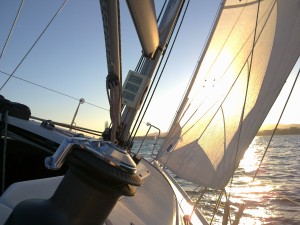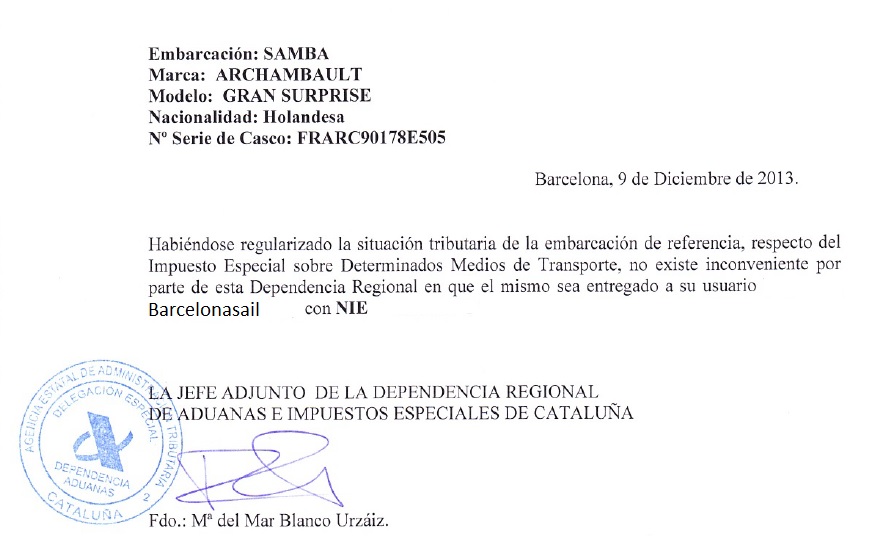Buying a boat in Spain, Tax and other Duties
Buying a boat in Spain is painful. It is true, the boat requirements and sailor certifications in Spain are neither sensitive nor sensible. We are going through the issues and tackle them one by one, based on our experience with the BarcelonaSail boat in Barcelona. The Spanish government, keen on reducing its ballooning debt, invent new regulations every year for boat safety, communication equipment, and things such as toilet requirements and a minimal number of buckets reducing your fun sailing in Barcelona. A detailed requirement list can be found in the GUIA AD 2021.
Safety equipment
Depending on your boat safety equipment, you are allowed to sail a certain distance from the shore line. The Spanish government has invented 7 different zones, ranging from 0 mile (within harbor or protected waters), 2 mile , 5 mile 12 mile 25 mile 60 mile to unlimited, zona 1.
Upon buying a boat in Spain your boat will be certified, at your cost, for one of these zones. Many sailboats we see are in category (zona) 4, (maximum 12 miles from the shore) and thus not allowed to sail to the Balearic islands (zona 2). Additional cost to get your boat licensed for zona 2 will be well over 4000 euro. Safety equipment such as a lifeboat needs to be tested yearly, by a Spanish-certified institute at your cost. The boat has to go out of the water every 5 years, not to document errors in the hull, but to check if the boat meets the theoretical requirements. To be honest in reality these requirements are not always enforced, none the less it leaves you with an uncanny feeling.
Spanish Boat registration
Boats are registered in 11 different ways, so called “lista” depending the usage of the boat mostly related to tax. Try to get a “lista septima” or “lista 7″ boat, that is for individual use no business purpose. It is easy to find out for Spanish registered boats what registration they have. The fist character of the identification number on the hull indicates the “lista” category. You need to be a certified sailor no matter how many miles you have sailed. The best thing is to get an ICC, international certificate of competence, make sure you get a Spanish translation that states your are classified as “capitan de yate”, else you are restricted to sailing a certain distance from the coast. It is good to know that all this piracy on your wallet applies mainly for the Mediterranean.
Buying a boat in Spain (Spanish flagged)
Spanish and foreign residents who want to buy a Spanish flagged boat in Spain are taxed on owning a boat and on the purchase of a boat. The definition of “Spanish resident” is straightforward everybody living more than 180 days a year in Spain. Described here is the taxation on purchasing a boat for personal use in the following three scenarios:
1. Buying a new boat
2. Buying a second hand Spanish flagged boat from a private party (private use)
3. Buying a second hand Spanish flagged boat from a business (business use, renting)
Scenario 1. Buying a new boat is pretty straight forward there are two kinds of tax you pay:
Impuesto Especial de Matriculación 12% and the Impuesto sobre el valor añadido (VAT) 21%
Scenario 2. Buying a second hand boat from a private party means that the boat is registered in as lista 7 = private use. The taxation Impuesto sobre Transmisiones Patrimoniales is 4%.
Scenario 3. Buying a second hand boat from a business (charter boat is registered as lista 6) is more complicated. A business may pay the taxation Impuesto Especial de Matriculación 12% and (VAT) 18% over a period of 4 years. So in case the boat is four years old or younger you may have to pay up to 30% on top of the sale price. In case the boat is older than 4 years and your have proof that the taxes are paid you pay no tax at all. The clock start ticking at the registration date which you can find on the “Hoga de Asiento”. Paperwork next time.
Summary Spanish boat taxes and duties
When buying a boat in Spain the following taxes and duties may be levied:
- New Boat Private (Personal use= lista 7)
Impuesto Especial de Matriculación 12%
Impuesto sobre el valor añadido (I.V.A.) 21%
Impuesto sobre Transmisiones Patrimoniales 0% - Second Hand Boat Private (lista 7) to Private (lista 7)
Impuesto Especial de Matriculación 0%
Impuesto sobre el valor añadido (I.V.A.) 0%
Impuesto sobre Transmisiones Patrimoniales 4% - Second Hand Boat Busines (=lista 6) to Private (= lista 7) tax not paid
Impuesto Especial de Matriculación 12%
Impuesto sobre el valor añadido (I.V.A.) 21%
Impuesto sobre Transmisiones Patrimoniales 0% - Second hand boat for Busines (=lista 6) to Private (= lista 7) tax paid
Impuesto Especial de Matriculación 0%
Impuesto sobre el valor añadido (I.V.A.) 0%
Impuesto sobre Transmisiones Patrimoniales 0%
Buying a foreign flagged boat in Spain
In case you buy a second hand (used) foreign flagged boat, for example a sail boat from France, you will have to pay the Impuesto Especial de Matriculación 12% over the listed new value of the boat and don’t forget the VAT . This is an item to check carefully before purchasing a foreign flagged boat.
Re-flagging your boat, register a boat, Spanish to other country
After re-flagging our sailboat Samba from a Spanish flag to a Dutch flag, we encountered ferocious attacks in three separate cases from three entities:
- Aduana (Customs)
- Guardia Civil (police)
- Hacienda (tax collection)
Barcelonasail purchased her first sail boat in Spain with the help of a Spanish lawyer to make sure all the boat papers were in order. We decided to register our sail boat in the Netherlands. The process in the Netherlands was transparent and fast. Whereas it took almost one year to remove the boat from the Spanish register.
6 months later after reflagging the boat we received a letter from Aduana summoning us to pay the Impuesto Especial de Matriculación (12% of the new value) estimated at 18.000 euro. We informed that the boat was purchased in Spain and sent Aduana a copy of the old Spanish boat papers. Never throw them away! Aduana accepted the legality and they sent us an acceptance letter. We thought the case was over.
However a few months later we received a similar letter from Hacienda, Spanish tax authority, a copy from the Aduana acceptance letter was enough to satisfy them.
The Barcelona Guardia Civil, located in the building as Aduana, did not accept our old Spanish boat papers nor the letter from Aduana. Guardia Civil started a case under the presumption that the Spanish administration must have made a mistake. After 6 months we received the letter below. We carry a copy onboard and needed it already two times. Beware when buying a boat in Spain.
Practical experience buying a boat in Spain
We are so close to buying our Archambault Grand Surprise, and every time something comes in between. Twice we have made an appointment with the seller to transfer the boat on to our name. Twice we couldn’t agree. We are buying from a private party; we went directly to the owner to skirt broker fees. After this experience, there is something to be said for a boat broker, however, the costs are huge. Boats in Spain need to be certified every 3 or 5 years. Three-year inspection for commercial boats called in Spanish “lista 6” and every 5 years for a private boat “lista 7”. The inspeccion is called “Inspección de Embarcaciones de Recreo (ITB)”. After your inspection, you receive an airworthiness certificate valid for 5 years (Certificado de Navegabilidad).
It is common that the seller makes sure that the airworthiness certificate is still valid at the date of sale. Beware that it takes 6 weeks to get a new certificate and that sailing without a valid certificate is considered a severe crime resulting in your boat taken until the certificate is processed.
We discovered that there was one day left on the current certification and this was not acceptable to us. The owner hesitated, then agreed, and a week later everything would be OK. Then we learned that the whole process takes 6 weeks, which means no sailing until August, or looking for a different boat. But we are already in love with our Archambault Grand Surprise.



